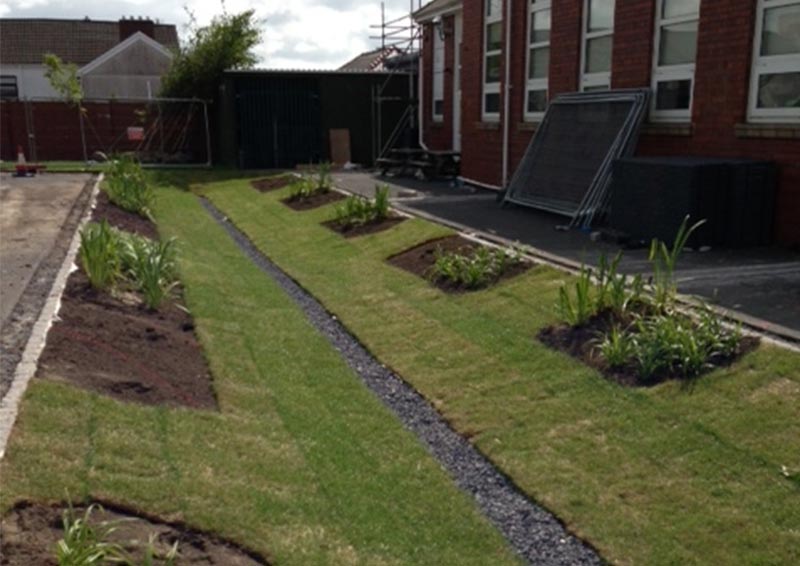Surface drainage
We don’t design a road through a pylon or a house through a gas main so why don’t we design surface drainage properly?
Ian Titherington, Lead Officer, Cardiff City Council calls for recognition that this most inflexible public utility, should be considered first and not last.
Contents |
[edit] Introduction
My current substantive role, as a civil engineer in local government, is to advise on all drainage matters relating to planning applications. These can range from simple house extensions to housing developments of over 7,000 homes, so it’s fair to say that the depth and detail of information supplied can vary somewhat.
However, there is an all too frequent problem that I run into, whatever the size of the application – an inability to account for surface water management at the beginning of the application.
[edit] Ignoring advice and making fundamental errors
I am not clear why such a fundamental error occurs so frequently, often being repeated despite our written and verbal advice otherwise. During such moments of (repeated, unnecessary) exasperation, I have come to the conclusion that the best way to avoid this is by treating surface water management just like any other public utility.
Just sit back for a minute and put gas, electricity, fibre optics, water supply, sewage and surface water all in the same group. Then, ask yourself which are the easiest and which is the hardest to design into a new development. Finally, ask yourself which is usually left until last. Yes, it’s rainfall run-off – the very hardest to manage.
[edit] Why do we put surface water last?
There lies the crux of the problem. The development industry often has a blind spot when it comes to surface water, which can result in increased construction costs, delays in planning and - if it goes badly wrong - the dreaded loss in housing density.
You may say that this is a very rare occurrence, but I beg to differ. I will often find myself working with an embarrassed designer, trying to retrofit drainage on a development that has yet to be built. On a sizeable development, is it really beyond the gift of developers to recognise the green/blue corridors, do a few BRE 365 tests, model exceedence flow directions and draft out flows, soakaways and attenuations? You would not stick a road through a pylon or a house on a gas main, so why do it to surface water?
[edit] Getting more SuDS happening in throughout the UK
Understanding surface water as a (forgotten) public utility can really help everyone involved in a development get the highest quality and highest value sustainable urban drainage system (SuDS) included in developments, whichever part of the UK they’re working in.
However, in Wales we may well be taking action to stop this by implementing schedule 3 of the Flood & Water Management Act. In theory, this legislation when enacted in November 2018, should not only put good SuDS practice at the heart of good site design, but also force developers to recognise that the most inflexible public utility should be considered first and not last. It is in everyone’s interests that they do so.
This article was originally published here on 26 March 2018 by ICE. It was written by Ian Titherington, Lead Officer, Cardiff City Council.
--Institution of Civil Engineers
[edit] Related articles on Designing Buildings WIki
Featured articles and news
CLC Health, Safety and Wellbeing Strategy 2025
Launched by the Minister for Industry to look at fatalities on site, improving mental health and other issues.
One of the most impressive Victorian architects. Book review.
Common Assessment Standard now with building safety
New CAS update now includes mandatory building safety questions.
RTPI leader to become new CIOB Chief Executive Officer
Dr Victoria Hills MRTPI, FICE to take over after Caroline Gumble’s departure.
Social and affordable housing, a long term plan for delivery
The “Delivering a Decade of Renewal for Social and Affordable Housing” strategy sets out future path.
A change to adoptive architecture
Effects of global weather warming on architectural detailing, material choice and human interaction.
The proposed publicly owned and backed subsidiary of Homes England, to facilitate new homes.
How big is the problem and what can we do to mitigate the effects?
Overheating guidance and tools for building designers
A number of cool guides to help with the heat.
The UK's Modern Industrial Strategy: A 10 year plan
Previous consultation criticism, current key elements and general support with some persisting reservations.
Building Safety Regulator reforms
New roles, new staff and a new fast track service pave the way for a single construction regulator.
Architectural Technologist CPDs and Communications
CIAT CPD… and how you can do it!
Cooling centres and cool spaces
Managing extreme heat in cities by directing the public to places for heat stress relief and water sources.
Winter gardens: A brief history and warm variations
Extending the season with glass in different forms and terms.
Restoring Great Yarmouth's Winter Gardens
Transforming one of the least sustainable constructions imaginable.
Construction Skills Mission Board launch sector drive
Newly formed government and industry collaboration set strategy for recruiting an additional 100,000 construction workers a year.
New Architects Code comes into effect in September 2025
ARB Architects Code of Conduct and Practice available with ongoing consultation regarding guidance.
Welsh Skills Body (Medr) launches ambitious plan
The new skills body brings together funding and regulation of tertiary education and research for the devolved nation.
Paul Gandy FCIOB announced as next CIOB President
Former Tilbury Douglas CEO takes helm.


























